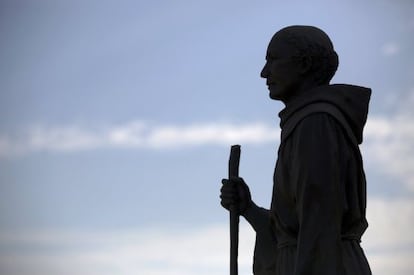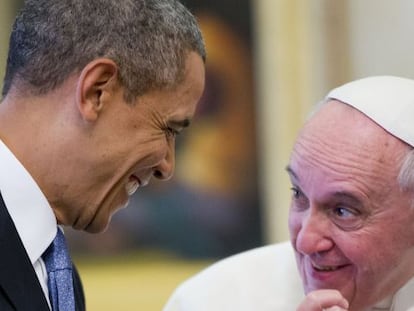Junípero Serra: a new saint for the US Hispanic community
Church holds up Spanish-born friar canonized by Pope Francis as a symbol for Latinos


The canonization of 18th-century Spanish missionary Father Junípero Serra, who was made a saint by Pope Francis in Washington on Wednesday, represents a strategic move by the Catholic Church in the United States.
During a conference in May, Los Angeles Archbishop José H. Gómez called Serra the “first Mexican immigrant” because “he lived and worked more than a dozen years in Mexico before coming to California.”
In a way, Gómez is right.
California has statues of Serra and President Ronald Reagan at the US Capitol in Washington
The Mallorca-born missionary, who lived from 1713 to 1784, traveled with Spanish expeditions to help convert the Native American communities living in what is now California to Christianity.
At age 56, he arrived in the unexplored Spanish territory and later set up nine missions between San Diego and San Francisco; these missions today are preserved as important historic sites.
Although he is not well-known in Spain, Father Serra is a monumental figure in California history. His biography is studied in schools and the story of the American West cannot be told without mentioning Serra’s name.
In the rotunda of the US Capitol in Washington DC, each US state is represented by two statues of illustrious figures. California has statues of Serra and of President Ronald Reagan.
According to historian Steve Hackel, Serra “said that he was going to die in California preaching the Gospel and that’s what he did.”
“He is our Christopher Columbus, our Hernán Cortés,” Hackel said in an EL PAÍS interview before Serra was made a saint.
In his book, Junipero Serra: California’s Founding Father, Hackel describes the friar as part of an often overlooked episode of US history. When the Revolutionary War broke out between the Colonists and Britain, and America’s new leaders were busy drafting a Constitution back east, Serra was preaching the gospel to the Native American tribes that populated California.
Contrary to the golden empires that the Spanish Conquistadors found in Mexico and Peru, the tribes in California were nomadic hunters-gatherers who numbered about 300,000.
The Spanish missions were the first buildings and churches to be constructed in the far west of the continent. Other missions had previously been established in what is now modern-day Texas.
Until the Gold Rush of the mid-19th century brought in prospectors and other migrants from the east, California was predominantly Hispanic and Catholic.
Canonization is something very powerful and personal for those of us who are Hispanic or Mexican” Los Angeles Archbishop José H. Gómez
Today, Latino-Hispanics make up 40 percent of the state’s population and projections show that the community will keep on growing.
The Los Angeles Archdiocese, the largest in the United States, has been a major supporter of Serra’s canonization.
At the same time, Archbishop Gómez, who was born in Monterrey, Mexico and served as archbishop in Denver and San Antonio – two large US cities that are predominantly Hispanic – has come out in favor of President Obama’s migration reform bill as a solution to resolving the legal status of the around 11 million undocumented people living in the United States.
“This canonization is even more powerful and personal for those of us who are Hispanic or Mexican,” Gómez said.
“As we know, the Latino migration, especially from Mexico, is changing the face of the Catholic Church as well as US society. That is why it is so significant that Junípero will become the first Hispanic saint in the United States.”
English version by Martin Delfín.
Tu suscripción se está usando en otro dispositivo
¿Quieres añadir otro usuario a tu suscripción?
Si continúas leyendo en este dispositivo, no se podrá leer en el otro.
FlechaTu suscripción se está usando en otro dispositivo y solo puedes acceder a EL PAÍS desde un dispositivo a la vez.
Si quieres compartir tu cuenta, cambia tu suscripción a la modalidad Premium, así podrás añadir otro usuario. Cada uno accederá con su propia cuenta de email, lo que os permitirá personalizar vuestra experiencia en EL PAÍS.
¿Tienes una suscripción de empresa? Accede aquí para contratar más cuentas.
En el caso de no saber quién está usando tu cuenta, te recomendamos cambiar tu contraseña aquí.
Si decides continuar compartiendo tu cuenta, este mensaje se mostrará en tu dispositivo y en el de la otra persona que está usando tu cuenta de forma indefinida, afectando a tu experiencia de lectura. Puedes consultar aquí los términos y condiciones de la suscripción digital.
More information









































